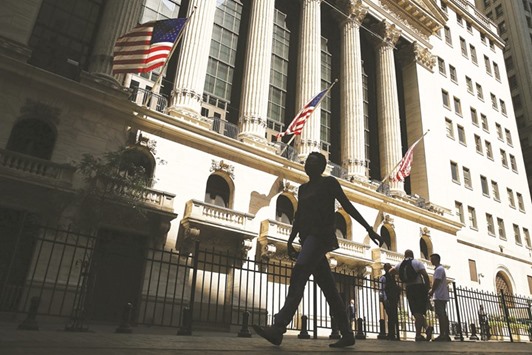If US stock investors are true believers in President Donald Trump’s economic agenda, count members of the Federal Reserve as agnostics.
The S&P 500 Index rose in seven of Trump’s first eight weeks in office before suffering on Tuesday its biggest one-day setback under the new administration. Yet the Fed appears unswayed by the market’s euphoria. It unveiled forecasts last week that showed officials predict about 2% growth in the first three years of Trump’s presidency – little changed from their December estimates. Also unaltered was their expectation for three interest-rate increases in 2017 and three next year.
The Fed’s cautious outlook shows central bank officials aren’t prejudging whether Trump can deliver on a plan to revitalise the US economy with shock therapy: deregulation, infrastructure spending, retooled trade agreements and tax reductions intended to raise growth to 3% or more.
Trump’s first two months in office are proving that getting an ambitious agenda through even a Republican-controlled Congress is easier said than done. “There are a lot of hopes and dreams built around this administration,” said Ellen Zentner, chief US economist at Morgan Stanley in New York. “It is a tall order to deliver.”
For eight years, the expansion has been driven by Fed monetary policy that kept interest rates at or only slightly above zero. But now, as it raises rates and slowly withdraws from the stimulus game, the Fed is effectively handing off the burden of spurring growth to the White House and Congress. They control the levers of fiscal policy – taxes, infrastructure spending, and a key propellant the economy needs to reach a higher gear: federal funds to invest in human or physical capital that yields more output per hour.
When asked how the Fed is responding to the Trump economic plan, Fed Chair Janet Yellen said at her March 15 press conference: “There is great uncertainty about the timing, the size, the character of policy changes that may be put in place.” She said some Fed officials had “pencilled in” some fiscal policy changes into their forecast, while “we have plenty of time to see what happens.”
The Fed’s forecast underscores its view that there aren’t any inflation-inducing booms in store for the economy soon.
“They don’t see regime shift” and “are definitely not incorporating some comprehensive reform into their forecast,” said Ethan Harris, head of global economics research at Bank of America Merrill Lynch. Indeed, the top end of the range of gross domestic product growth forecasts from 17 Fed officials was 2.4% in 2018.
Their longer-run estimate of how fast the economy can grow was unchanged in their most recent forecast at 1.8%.
Stock investors still anticipate that the Trump plan could be a boon for corporate profits, giving growth a big boost at a time when the rest of the world is looking healthier: China’s economy has stabilised and Brexit hasn’t turned out to be a disaster in the UK that spread to the rest of Europe. “When was the last time the economy was as healthy as it is today, and Washington began to talk about a cocktail of fiscal stimulus, deregulation, and tax cuts?” said Richard Bernstein, who oversees more than $4bn at the New York investment firm that bears his name. “The answer is never.”
Some of the excitement fizzled Tuesday. A stock benchmark constructed by Richard Bernstein Advisors called the RBA American Industrial Renaissance Index, which includes companies such as RBC Bearings and American Railcar Industries, sank on Tuesday to its lowest level since early December, but is still up about 18% since the election.
There’s a lot at stake for people of all incomes: The economy will either prosper and accelerate with productivity-enhancing investment, or slog along with the moderate growth and meagre compensation gains for workers. At the heart of the Republican tax reform proposal is a cut in corporate rates to 20%, from 35%, the biggest reduction in history, Republicans say. Corporate investment expenditures can be fully written off.
Ike Brannon, a former tax specialist in the US Treasury Department under President George W Bush, said that Republican plan could boost productivity by stimulating investment.
A measure of such spending slumped for four consecutive quarters before rising at a 1.9% annual rate in the final period of last year, a dire sign of corporate expectations about the future.
By moving the corporate tax rate more in line with other countries, it could also provide incentives for US companies to keep operations here instead of moving them offshore, and possibly create more jobs, Brannon said.
That gets to the political delicacy of the Trump experiment. If the whole package fails to deliver faster growth and simply skews toward the wealthy and to stock investors, then a significant part of his constituency hasn’t won anything.
“If Trump doesn’t deliver for middle-class people, they are going to look for something else,” said Brannon, who is now president of consultancy Capital Policy Analytics.
“They understood that he was going to look after them first.” And then there’s Congress. While Republicans have a majority in both chambers, the troubled Trump-backed effort to repeal and replace the Affordable Care Act shows just how difficult it is to pass a big, sweeping law with multiple stakeholders. A loss or a prolonged political battle could sap the president’s political strength if it goes down in defeat.

People walk by the New York Stock Exchange. The S&P 500 Index rose in seven of Trump’s first eight weeks in office before suffering on Tuesday its biggest one-day setback under the new administration. Yet the Federal Reserve appears unswayed by the market’s euphoria.


